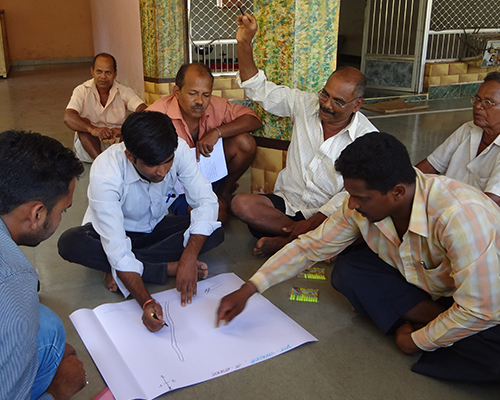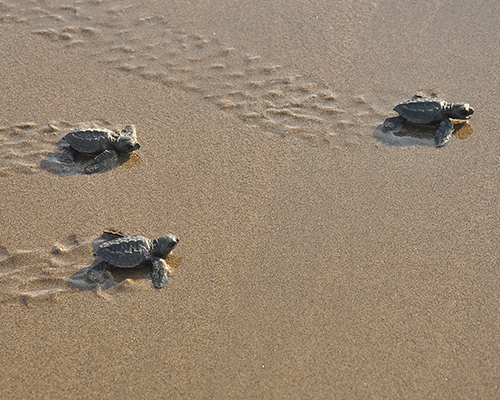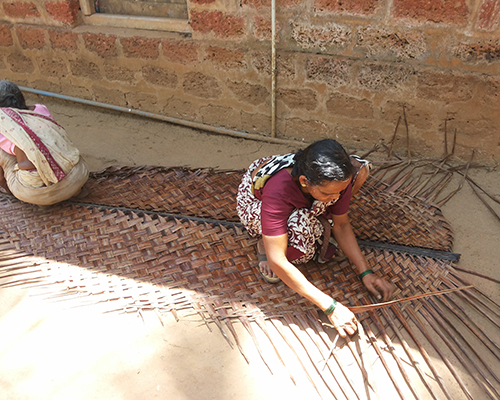Bioprospecting
Bioprospecting
Sustainable Communities
- Livelihood Support and Nutritional Security through Food Processing and Fortification
- Nutritional Security and Livelihood Support through Off-farm Livelihood initiatives
- Nutritional Security through Nutri-Gardens and Food Fortification
- Developing Pathardi in Palghar District into a Sustainable Village
- Canteen for Teens - Focusing on "Know, Grow and, Cook your own food" for Urban Youth
- Urban Farming - A Sustainable Approach for Urban Nutrition
Biodiversity Action Plan for Sindhudurg District of Maharashtra State Duration: 2011-2013 Sponsor: Mangrove Cell, Govt. of Maharashtra
A study primarily focused on understanding the natural resource consumption patterns, livelihood options of the local communities, infrastructure gaps and the effect of these and anthropogenic activities on coastal and marine biodiversity was undertaken at 136 villages (78 villages of Malvan and 57 villages of Devgad block) in Maharashtra's Sindhudurg district. The aim was to determine the impact of activities in coastal villages on marine biodiversity and assess the issues pertaining to rural development. The study also focused on identifying the key Entry Point Activities (EPAs), major infrastructure gaps, village level livelihood and human development needs which would ultimately help in preparing micro–plans to minimize the impact on marine biodiversity and the Biodiversity Action Plans for the sustainable development of coastal villages.
 A Participatory Rural Appraisal activity in progress
A Participatory Rural Appraisal activity in progress It was found that the biodiversity of the region was getting drastically affected by anthropogenic impacts such as habitat destruction and fragmentation, deforestation, mono-culturing, competitive fishing practices such as bottom trawling and use of purse seine nets, use of unpermitted mesh-size fishing nets, fishing during breeding season in the sea as well as the creek, poaching of protected species, collection of sea-shells, lack of awareness and concern for conservation practices, increased artificial lighting along beaches and insufficient coast guard monitoring.
Natural Resource Assessment
The study revealed that the district has unique biodiversity resources in terms of marine species of fish, turtles, corals and so on. Local communities continue to use several medicinal plants for various purposes. Researchers identified two kinds of ecosystems broadly classified as terrestrial and marine. Terrestrial ecosystem consists of all the habitats such as deciduous forests, basalt plateaus, grasslands, scrub and freshwater wetland ecosystems. Marine ecosystem consists of offshore ecosystems and coastal belts such as mangroves, mudflats, estuaries and seashores.
 Rescued baby turtles making their way back into the sea
Rescued baby turtles making their way back into the sea Endangered species of birds and turtles are regularly visiting the coast for nesting and breeding. There is, however, a decrease in the frequency from the past 4-5 years, due to increased activities along the coast and deforestation. A systematic approach must be adopted and coherent efforts in collaboration with the local communities must be undertaken to preserve the rich biodiversity resources. The total forest area is covered by tropical wet evergreen, tropical semi-evergreen and south Indian tropical moist deciduous type of forests. Further, the area is divided in forests having laterite red soil and forests with sandy loams. About 38600 hectares of area is under forest. The lower slopes, flat hill tops and terraces are either under cultivation or under some sort of degraded tree growth as ―Malki or Inam‖ lands , while the treescape along the water bodies of the region consist of mainly teak, ain, kinjal, jamun, arjun, undil, jackfruit, cashews, mangoes, coconut and betelnut trees. The total forest area of Sindhudurg is 390 sq. kms. In the recent past, the trend of monoculture of fruit trees on privately-owned hill slopes has increased owing to economic benefits associated with it. However, it is severely affecting the ecological balance and food chain intermediates.
Livelihood options available
1. Agriculture
Agriculture is the major profession in both the blocks, with 90 percent of villages in Malvan and 80 percent in Devgad relying only upon agriculture either for self-consumption or for generating revenue. The second major source of livelihood is fishery with 10 percent of villages in Malvan and 20 percent in Devgad depending only upon fishery. Tourism is a major source of livelihood in 15 percent and 10 percent of villages in Malvan and Devgad blocks respectively.
Agriculture is primarily traditional with marginal mechanization. Farmers primarily cultivate paddy and mangoes. Rice is mainly cultivated for self-consumption. Mango is a major crop to sustain livelihood. Of the two, horticulture was identified the most harmful for the environment owing to the high use of pesticides and the fact that horticultural areas are established by clearing out natural forest patches. The survey highlighted use of pesticides beyond the prescribed dose to combat increasing pest infestation. Fragmentation and small land holdings, followed by non-implementation of watershed management projects, heavy pest infestation on mango trees and crop raiding by monkeys are the major constraints affecting agriculture.
2. Fishery
Fishing in Malvan and Devgad is traditional but is increasingly becoming mechanized through use of fibre boats with outboard motor used for gillnet, hook-and-line and cast-net technique of fishing. Use of mechanised trawlers has noticeably increased in the recent years. Traditional methods of fishing include Rampani, Shendi and gill net. Both coastal and creek fishing is practised in Malvan and Devgad. In Malvan, 11 out of 78 and in Devgad, 16 out of 57 villages are fishery villages. Out of total fish catch of 1647 metric tonnes, around 90 percent is consumed locally in Sindhudurg district.
 A lady engaged in making the traditional palm leaf mat
A lady engaged in making the traditional palm leaf mat Challenges in fisheries
The fishermen in the area face a number of challenges that have impacted their livelihood to a great extent. The fishermen complained of lack of basic infrastructure in terms of fully equipped jetty with cold storage facility and market for fish auctioning. The lack of marketing linkages is a major setback for the fishing industry. A gradual decrease in fish catch and number of local fish species like Indian salmon (Rawas), Jew fish (Ghol), pomphret, mussels, oysters, clams and so on. Local fishermen are facing stiff competition from those using purse seine net and large trawlers. Fishermen from other states are exploiting the fish catch in this region resulting in drastic reduction in the fish catch, they complained. Also most of their catch is sold to agents, the rates for which are pre-decided so the returns are poor since the input expenses have increased (picture no.
The low value fishes are dried and salted along the beach and packaged in coconut zap i.e. local packaging material made up of dried coconut leaves, which is an eco-friendly and low cost packaging method used at most of the fish landing sites such as Makrebag, Malvan, Devgad and so on. Most of the fishermen understand the impacts and ill effects of purse seine fishing and bottom trawling but continue to follow the practice due to heavy investments incurred in the fishing vessels and low catch of fishes in the recent past.
Migration of youth could be checked if modern options of revenue are created at the district level. As apathy towards traditional agriculture and fishery is increasing, newer options like training for ornamental fishery, scuba diving and tourism related activities may be useful in retaining the youth in the district.
Tourism although an important source of livelihood id developed also comes with a host of problems if not developed in a sustainable manner. There is a loss in areal biodiversity due to increasing conversion of forest or canopied areas into settlements/ construction activities for building resorts. Owing to the booming tourism industry, more land is converted to non-agricultural land and resorts are built to attract tourists. Though this is helping the tourism industry, it is destroying the nesting sites of rare birds and other terrestrial species.
Thus it was found that means and methods needed to be devised to conserve biodiversity and at the same time provide livelihood options to people that utilize natural resources in sync with biodiversity. Options like agritourism, sustainable agriculture, agro forestry, conservation of sea animals, subsidies, entry point activities were proposed as part of the project aimed at achieving livelihood sustainability with biodiversity conservation.
Bio-prospecting, assessment, inventorization of the rich natural resources of the region was an essential component of the project. The resource maps were prepared through participatory approaches. The study revealed some important aspects about the major livelihood options of the villages in the study blocks. The study also revealed the need to create awareness about the resource potential and its sustainable utilization to build a harmonious balance with natural rhythms such as breeding cycles of fishes and flowering of horticultural species of commercial significance. Furthermore, the potential of the local produce and its processed products can be tapped to generate revenue opportunities for the farmers, fisher communities, women and especially the youth.
The recommendations included in the action plan take into account the local traditions, practices that are deeply integrated into the society and the newer trends and livelihood options, which are being rapidly internalized into the cultural aspects of the district. Implementation of this action plan would pave way for a paradigm shift of the region towards sustainable development, ensuring biodiversity conservation.
